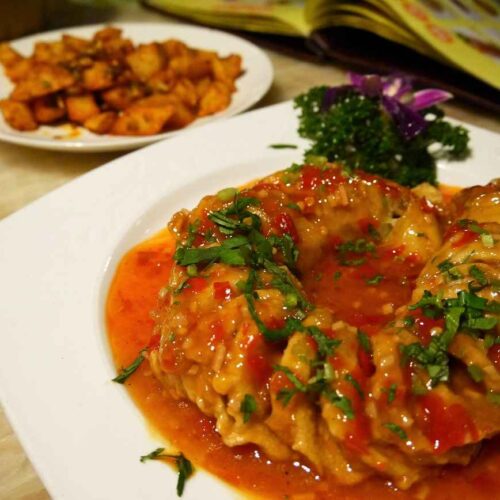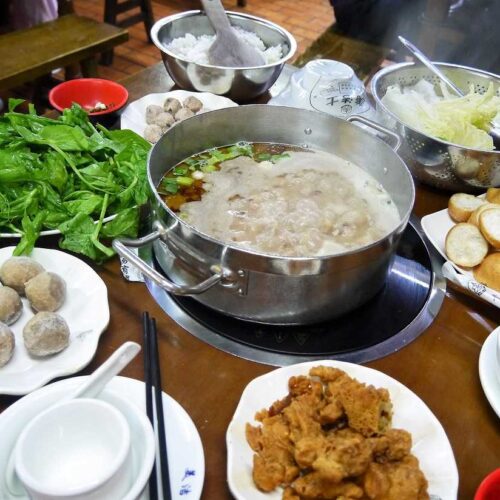Guiyang’s food can be an acquired taste for newly arrived expats. Strong sour and spicy flavors dominate, and no oil is spared in cooking a dish. One of the most common questions locals have for expats is “Have you become accustomed to the food?” For the most part, Guiyang’s lajiao is the pride of the cuisine. People refer to most forms of chili as làjiāo, or “hot pepper,” but there are different types for different meals, and each has a different level of spice.
Húlàjiāo (煳辣椒), or toasted lajiao (pictured below) is the most common lajiao in Guiyang. The color ranges from deep red to a toasty brown. It’s simply dried and roughly ground chilis, and is used to mix a dipping sauce for hotpot or dumplings, or sprinkled on bowls of noodle soup. Many hotpot restaurants have a table with assorted ingredients for you to mix your own dipping sauce. If you spot a bowl of lajiao with larger flakes, or pieces of dried chili, you’re probably staring down a bowl of húlàjiāo.
It can vary from not particularly spicy to holy-hell-what-did-they-put-in-this spicy, but you can mix it to taste. When the servers mix up dipping sauce for you, it’s most often accompanied by green onion, a bit of medicine root, and perhaps some garlic or fermented tofu. Usually, for hotpot you add some of the soup or sesame oil to make a sauce, and for dumplings you can top it up with soy sauce and vinegar. In the photo here, you can see the giant stone mortar in which the lajiao is ground.
Yóulàjiāo (油辣椒), or oil lajiao, is dried, ground lajiao mixed with oil. The most famous iteration is Guiyang’s own world famous brand, Lǎogānmā (老干妈), The Godmother. It’s so widespread I was able to buy it in my hometown of 60 000 people in Canada. It’s generally on the less spicy side of the local chili offerings, so it’s a pretty great starter lajiao for new expats. Many street-side fried rice stands use it as their go-to lajiao for frying, and it’s used in a lot of home cooking. It’s also used to top strips of cold rice patty to make mǐdòufu.
I’ve always kept a jar or two of Lǎogānmā in my fridge, as its salty, spicy flavor is a nice last-minute addition to a bland dish. There may be meat ingredients or peanuts mixed in, however, so if you are allergic or have a special diet, you’ll probably need to ask about the ingredients you can’t have. The jar in the photo shows vegetable oil, lajiao, chicken, MSG, salt, garlic and sugar as the ingredients.
Làjiāofěn (辣椒粉), or lajiao powder, is a bright orangey-red chili powder served with the city’s BBQ. Salty, spicy, and frequently numbing, it adds quite a kick to whatever you’re eating. It’s a staple spice when eating luoguo or on grilled veggies and meat skewers.
If you have a peanut allergy, be careful with làjiāofěn, as it frequently has crushed peanuts. Tell the server:
“Wǒ duì huāshēng guòmǐn. Zhège làjiāo yǒuméiyǒu huāshēng?”
(我对花生过敏。这个辣粉有没有花生?) I have a peanut allergy. Are there peanuts in this lajiao powder?
Other common ingredients include sesame seeds, salt and huājiāofěn (ground Sichuan numbing pepper).
Cíbālàjiāo (糍粑辣椒) is a special local chili concoction specially made for one of Guiyang’s specialties, làzijī (辣子鸡), spicy chicken. Unlike the battered and deep-fried spicy chicken of fast food restaurants back home, Guiyang làzijī is a one-pot meal of chopped, bone-in chicken pieces, stewed in an unbelievable amout of oily, spicy cíbā.
As you can see in the photo here, from Wandong Farmers’ Market by Hunter Mall, the cíbālàjiāo is ground from fresh chilis in a big hand-cranked grinder. Though every vendor has their own special blend, this lajiao should always contain ginger and garlic, along with salt and white pepper.
Shēnglàjiāo (生辣椒), or raw lajiao, has got to be the spiciest variety of lajiao on the list. Even typing this out makes my nose run a bit. It’s simply sliced red or sometimes green lajiao, with seeds in, and often crushed a little bit to release the spicy flavor. Some hotpot places offer this instead of húlàjiāo. Beware. The innocent-looking small pieces of lajiao floating in soy sauce can lull you into a false sense of security. Dip a finger in it, and have a taste. Use it sparingly, or face a bad case of burning ring in the morning. (It’s totally worth it, though.)
Honorable mention goes to a Sichuan variety of pepper, huājiāo (花椒), or Sichuan peppercorn. The peppercorns are the seeds of prickly ash, and are dried, ground and added liberally to many a dish. You can also find huājiāo oil in your local supermarket, which is nice because it distributes the flavor better than cooking with the whole peppercorn. The spice is used whole in chongqing hotpot and malaxiangguo. I refer to the whole seeds as grenades, as a hidden one in a bite of food sets of a numbing explosion in your mouth. Anything called málà (麻辣) has these little guys in it, and will leave you happily drooling and fanning your mouth.
If you have any questions or want to suggest an improvement to this guide, please let me know below in the comments. I asked for a lot of help from friends and market vendors to write this guide, but I’d love to improve it with more local knowledge!







